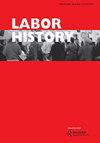Post-colonial structure of the Indian garment industry and its role in maintaining the precarity of women workers
IF 0.7
4区 管理学
Q1 HISTORY
引用次数: 0
Abstract
ABSTRACT Neoliberal policies and decentralization of production activities in developing countries have been blamed for the ever-increasing precarity of labor in India since the late twentieth century. Precarious labor, however, had long been a characteristic feature of the Indian garment industry before it actively participated in neoliberal global garment trade in the 1970s and 1980s. This study examines policies that shaped the Indian garment industry in the post-colonial period from 1947 and their effects on production, employment patterns, and women’s work. It employs the Indian Government’s official industry censuses and employment survey reports. Accordingly, the policy of small-scale garment production was backed by benevolent aims of reviving traditional Indian crafts and maximizing employment. However, it yielded a fragmented industrial structure and a pool of precarious labor from a poverty-stricken population. Gender-based social stereotypes further enabled a socio-economically disempowered female workforce. The neoliberal policies that gained ground with the industry’s increasing export orientation exacerbated the precarious working conditions rooted in indigenous policy-making and social mindset. Locating labor precarity and women’s vulnerability within this complex mesh of local and global factors offers an improved framework for testing how neoliberal policies maneuver them to influence production and employment patterns in today’s garment industry.印度服装工业的后殖民结构及其在维持女工不稳定方面的作用
自20世纪后期以来,发展中国家的新自由主义政策和生产活动的分散化一直被指责为印度劳动力日益不稳定的原因。然而,在20世纪70年代和80年代积极参与新自由主义的全球服装贸易之前,不稳定的劳动一直是印度服装业的一个特征。本研究考察了1947年以来后殖民时期塑造印度服装业的政策,以及这些政策对生产、就业模式和妇女工作的影响。它采用印度政府的官方行业普查和就业调查报告。因此,小规模服装生产的政策得到了复兴传统印度工艺和最大化就业的善意目标的支持。然而,它造成了支离破碎的产业结构和大量贫困人口的不稳定劳动力。基于性别的社会陈规定型观念进一步使女性劳动力在社会经济上被剥夺了权力。新自由主义政策随着该行业日益增加的出口导向而获得支持,加剧了植根于当地政策制定和社会心态的不稳定工作条件。将劳动不稳定性和妇女的脆弱性置于本地和全球因素的复杂网络中,为测试新自由主义政策如何操纵它们影响当今服装行业的生产和就业模式提供了一个改进的框架。
本文章由计算机程序翻译,如有差异,请以英文原文为准。
求助全文
约1分钟内获得全文
求助全文
来源期刊

Labor History
Multiple-
CiteScore
1.00
自引率
28.60%
发文量
44
期刊介绍:
Labor History is the pre-eminent journal for historical scholarship on labor. It is thoroughly ecumenical in its approach and showcases the work of labor historians, industrial relations scholars, labor economists, political scientists, sociologists, social movement theorists, business scholars and all others who write about labor issues. Labor History is also committed to geographical and chronological breadth. It publishes work on labor in the US and all other areas of the world. It is concerned with questions of labor in every time period, from the eighteenth century to contemporary events. Labor History provides a forum for all labor scholars, thus helping to bind together a large but fragmented area of study. By embracing all disciplines, time frames and locales, Labor History is the flagship journal of the entire field. All research articles published in the journal have undergone rigorous peer review, based on initial editor screening and refereeing by at least two anonymous referees.
 求助内容:
求助内容: 应助结果提醒方式:
应助结果提醒方式:


